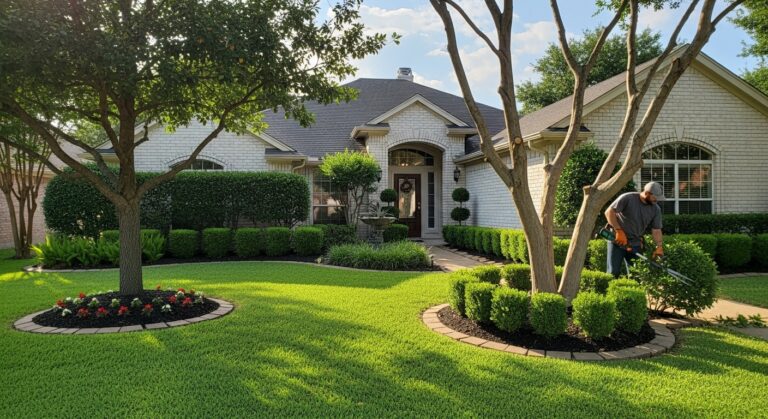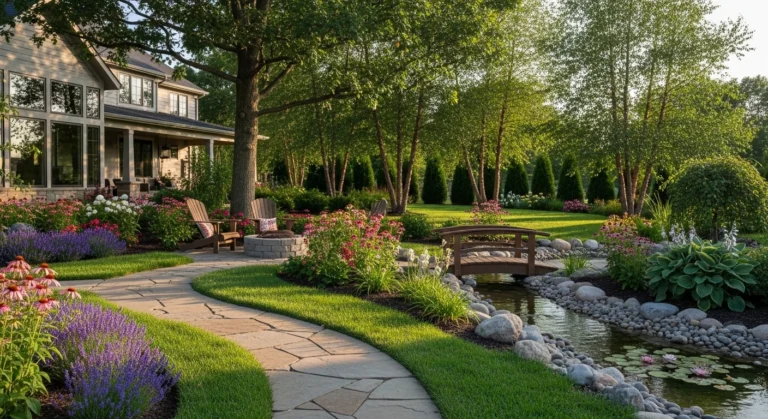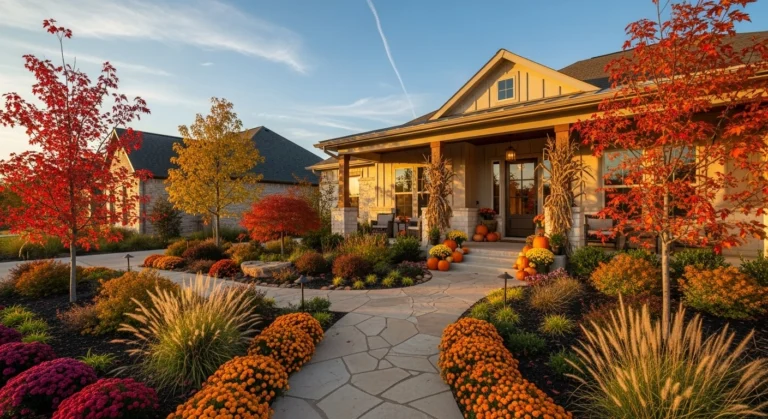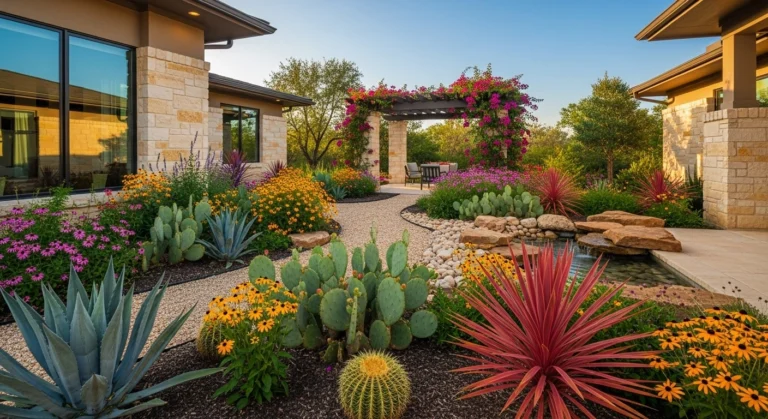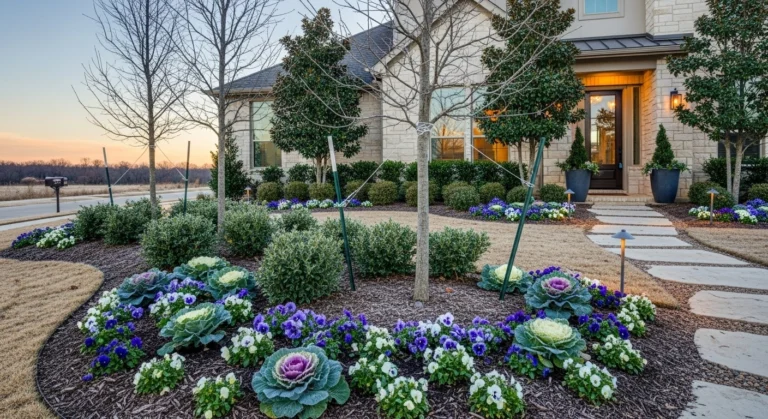Plant Selection Guide for Central Texas Gardens
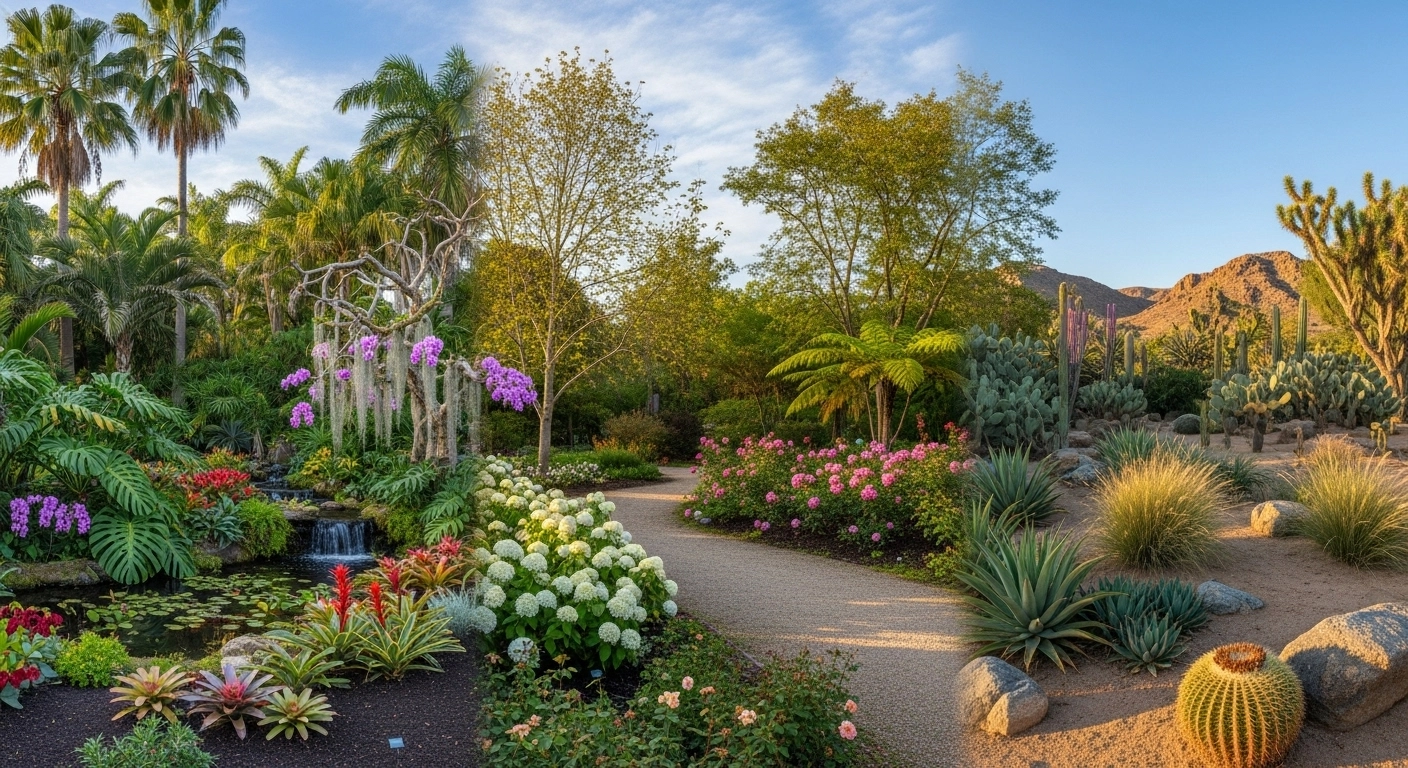
Picture this: you’ve spent another weekend replanting the same flower bed for the third time this year, watching your hard-earned money disappear into plants that looked gorgeous at the nursery but turned into expensive compost in your yard. Does this scenario sound painfully familiar? You’re definitely not alone – countless Waco homeowners fall into the trap of choosing plants based on beauty alone, ignoring the fundamental mismatch between their selections and our challenging Central Texas growing conditions. The frustration builds as you watch neighbors succeed while your own garden struggles, despite following the same care routines and investing just as much time and effort.
Here’s what we’ve learned after helping hundreds of Waco families create thriving landscapes: successful plant selection isn’t about having natural gardening talent or spending more money – it’s about understanding the science of environmental compatibility. When you choose plants that are naturally suited to our Zone 8a climate and unique soil characteristics, gardening transforms from an uphill battle into a rewarding experience. The secret lies in matching your plant choices to Central Texas conditions rather than fighting against them, creating gardens that flourish with significantly less water, fertilizer, and ongoing maintenance than traditional approaches require.
Central Texas Climate Realities and Plant Implications
Zone 8a gardening in the Waco area presents unique challenges that make cookie-cutter gardening advice ineffective for our specific region. Our climate features hot, humid summers with temperatures regularly exceeding 100°F, combined with unpredictable precipitation patterns that can swing from drought to flooding within the same season. Weather extremes including occasional ice storms, late spring freezes, and intense summer heat create conditions that stress plants not adapted to our specific environmental pressures.
Growing season length in Central Texas extends from March through November, offering opportunities for extended garden productivity but also creating challenges for plants that require winter dormancy periods. Humidity fluctuations throughout the year affect plant disease pressure and water requirements, with some plants thriving in our humid conditions while others struggle with fungal issues and poor air circulation.
Rainfall variability averages around 34 inches annually, but distribution patterns can be extremely uneven, with months of drought followed by periods of excessive moisture. This unpredictability makes water-smart plant selection crucial for creating resilient landscapes that can handle both extremes without constant human intervention. Our professional Landscaping Services focus on selecting plants that view these challenging conditions as normal rather than stressful.
Soil Characteristics That Shape Plant Success
Black clay soil dominates much of the Waco area, creating both opportunities and challenges for plant selection and garden success. This heavy clay soil holds moisture well during wet periods but can become rock-hard during dry spells, creating difficult conditions for root development and water penetration. Soil compaction from construction activity, foot traffic, and natural settling makes root penetration challenging for plants not adapted to dense soil conditions.
Alkaline pH levels typically ranging from 7.5 to 8.5 affect nutrient availability and limit the success of acid-loving plants that thrive in other regions. Nutrient binding in alkaline soils can create deficiency symptoms in plants not adapted to these chemical conditions, leading to poor color, stunted growth, and increased susceptibility to pests and diseases.
Drainage challenges vary significantly across Waco properties, with some areas experiencing standing water for days after heavy rains while others drain rapidly due to underlying rock formations or sandy deposits. Seasonal soil movement in clay soils can affect plant roots and hardscape elements, making flexible plant selection crucial for long-term landscape success and stability.
Strategic Approaches to Plant Selection Success
Climate-Adapted Plant Categories
Heat-tolerant perennials form the backbone of successful Central Texas gardens, providing reliable performance through our intense summer conditions while returning year after year with minimal replanting costs. Plants like Turk’s Cap, Autumn Sage, and Mexican Mint Marigold not only survive our heat but actually produce their best growth and flowering during the warmest months when other plants struggle.
Drought-resistant shrubs offer structural elements that maintain their appearance through seasonal variations while requiring minimal supplemental irrigation once established. Native shrubs including Agarito, Fragrant Sumac, and Possumhaw Holly provide year-round interest while supporting local wildlife populations and requiring virtually no ongoing maintenance after their establishment period.
Adaptable trees that can handle both wet and dry periods provide essential shade and structure while adapting to our unpredictable precipitation patterns. Live Oak, Texas Red Oak, and Cedar Elm develop extensive root systems that help them access moisture during dry periods while tolerating occasional flooding without suffering root damage or decline.
Soil-Specific Selection Strategies
Clay-loving plants include many Texas natives that have evolved specifically to handle our heavy soil conditions and actually perform better in clay than in amended or sandy soils. These plants have developed specialized root systems and physiological adaptations that allow them to thrive in conditions that would challenge or kill plants adapted to lighter, well-draining soils.
pH-tolerant species work naturally with our alkaline soil chemistry rather than requiring ongoing soil amendments to adjust pH levels artificially. Alkaline-adapted plants often display superior color, growth rates, and disease resistance in our natural soil conditions compared to their performance in neutral or acidic soils found in other regions.
Moisture-flexible plants can handle both the soggy conditions that occur during our wet periods and the drought stress that develops during dry spells, eliminating the need for complex drainage modifications or intensive irrigation systems. These versatile species provide consistent performance regardless of seasonal weather variations.
Creating Sustainable Plant Communities
Companion planting strategies that group plants with compatible water, soil, and light requirements create communities that support each other naturally while reducing overall maintenance demands. Symbiotic relationships between different plant species can improve soil conditions, provide natural pest control, and create more resilient ecosystems that require less human intervention.
Layered ecosystems that include canopy trees, understory shrubs, and ground-level plants create natural shade gradients and moisture retention patterns that benefit all community members. This approach mimics natural plant communities while providing more visual interest and seasonal variety than traditional single-layer landscape designs.
Succession planning ensures continuous seasonal interest through plants that peak at different times throughout the growing season, providing year-round appeal while working within Central Texas climate limitations. Sequential blooming and varied foliage textures create dynamic landscapes that remain attractive through seasonal transitions.
Native Plant Advantages for Central Texas Success
Top Performing Native Species
Texas wildflowers provide spectacular seasonal displays that rival any cultivated garden while requiring zero supplemental watering, fertilizing, or replanting once established. Bluebonnets, Indian Paintbrush, and Pink Evening Primrose create stunning spring color shows that attract beneficial insects and birds while thriving in our native soil conditions without any human intervention.
Native grasses offer low-maintenance alternatives to traditional turf while providing attractive texture and movement in landscape designs. Buffalo Grass, Little Bluestem, and Inland Sea Oats create beautiful ground coverage that remains attractive through seasonal changes while requiring minimal water and absolutely no mowing or fertilizing once established.
Indigenous trees and shrubs provide the structural foundation for sustainable landscapes while offering habitat for native wildlife and requiring minimal ongoing care. Mesquite, Texas Redbud, and Yaupon Holly develop into attractive specimens that improve with age while providing shade, screening, and seasonal interest without ongoing maintenance requirements.
Ecological and Economic Benefits
Native ecosystems support beneficial insect populations that provide natural pest control, reducing the need for chemical interventions while creating healthier growing conditions for all plants. Pollinator support from native plant communities contributes to overall garden health and productivity while supporting declining bee and butterfly populations that are crucial for ecosystem stability.
Water conservation benefits from native plant landscapes can reduce outdoor water usage by 60-80% compared to traditional landscaping approaches, resulting in significant long-term utility bill savings. Maintenance reduction translates to fewer hours spent on watering, fertilizing, pruning, and replanting, giving you more time to enjoy your outdoor spaces rather than constantly working to maintain them.
Property value enhancement through attractive, sustainable native landscapes appeals to environmentally conscious buyers while demonstrating responsible land stewardship practices. Long-term investment value increases as native plants mature and develop into more impressive specimens, unlike high-maintenance landscapes that can become liabilities if not constantly maintained.
Integration with Adapted Non-Native Species
Compatible additions from similar climates can complement native plant selections while expanding design possibilities and extending seasonal interest periods. Mediterranean herbs like Rosemary, Oregano, and Thyme thrive in our alkaline soils and hot, dry conditions while providing culinary benefits and attractive evergreen foliage.
Regional adaptations from other parts of Texas and similar climate zones often integrate seamlessly with local native species while offering additional options for specific design needs. Hill Country natives and East Texas species can work beautifully in Central Texas landscapes when their specific requirements match your site conditions.
Careful selection criteria for non-native additions should emphasize heat tolerance, alkaline soil compatibility, and water efficiency to ensure these plants can thrive alongside native species without creating conflicting care requirements. The goal is building integrated plant communities where all species support rather than compete with each other.
Soil Assessment and Improvement Techniques
Understanding Your Specific Site Conditions
Site analysis begins with observing how water moves across your property during rain events, identifying areas that drain quickly versus spots that hold moisture for extended periods. Microtopography affects drainage patterns, sun exposure, and wind protection, creating different growing zones that may require different plant selections within the same property.
Simple soil tests can provide valuable information about your specific growing conditions without requiring expensive professional analysis. Percolation tests involve digging holes and timing how long water takes to drain, giving you crucial information about drainage rates that affect plant selection decisions.
Seasonal observations of how your soil behaves during different weather conditions help you understand the full range of conditions your plants will experience throughout the year. Clay soil characteristics change dramatically between wet and dry periods, affecting root development, nutrient availability, and plant performance in ways that aren’t apparent from single-point-in-time observations.
Targeted Soil Improvements
Amendment strategies should focus on working with your existing soil characteristics rather than attempting complete soil replacement, which is expensive and often unsuccessful long-term. Organic matter additions like compost and native mulch improve soil structure gradually while supporting beneficial microorganisms that enhance overall soil health and plant performance.
Drainage modifications may be necessary in severely problematic areas, but often strategic plant selection can eliminate the need for expensive drainage projects. Raised beds and bermed plantings can improve growing conditions for specific plants while working within existing soil limitations rather than fighting against them.
pH management typically involves selecting plants adapted to your natural soil chemistry rather than attempting to modify large areas, which requires ongoing maintenance and can create nutrient imbalances. Targeted amendments for small, specific planting areas can be effective when growing particular plants that require different conditions than your baseline soil provides.
Sustainable Soil Health Practices
Long-term soil building through appropriate plant selection and organic matter management creates increasingly healthy growing conditions that support better plant performance over time. Deep-rooted plants help improve soil structure and nutrient cycling while reducing erosion and improving water infiltration rates.
Natural soil biology flourishes when you choose plants adapted to your existing conditions and avoid excessive chemical inputs that disrupt beneficial soil organisms. Mycorrhizal relationships between plant roots and soil fungi improve nutrient uptake and plant resilience while developing naturally in undisturbed, chemically balanced soil systems.
Maintenance-free approaches to soil health involve selecting plants that improve soil conditions naturally while requiring minimal ongoing inputs from homeowners, as outlined in our comprehensive Landscaping Guide resources.
Avoiding Common Plant Selection Pitfalls
Research Before You Buy
Impulse purchasing at nurseries often results in collections of incompatible plants that compete for resources or require conflicting care routines, creating ongoing maintenance challenges and poor performance. Seasonal displays at garden centers typically feature plants from various climate zones arranged for visual appeal rather than compatibility with local growing conditions.
Marketing influences can lead to plant choices based on trends or appearance rather than performance in your specific environment, resulting in expensive failures and ongoing frustration. Regional appropriateness should always take priority over aesthetic appeal when making plant selection decisions for long-term landscape success.
Information verification from multiple sources helps ensure plant recommendations are appropriate for Central Texas conditions rather than generic advice that may not apply to our specific climate zone and soil characteristics. Local expertise provides valuable insights into plant performance that may not be available in general gardening resources.
Understanding True Plant Requirements
Mature size misconceptions lead to spacing problems and eventual overcrowding that creates competition, poor air circulation, and increased disease pressure among plants. Growth rate expectations affect both immediate landscape appearance and long-term maintenance requirements, with fast-growing plants sometimes creating more work than slower, steady growers.
Care requirement underestimation results in landscapes that start manageable but become overwhelming as plants mature and their needs become more complex or demanding. Water requirement mismatches create conflicts between different plants in the same irrigation zone, leading to overwatering some species while underwatering others.
Seasonal appearance changes that aren’t anticipated can result in landscapes that look attractive during some periods but unappealing during dormant seasons or natural transition periods. Deciduous versus evergreen considerations affect year-round landscape structure and visual appeal in ways that may not be immediately obvious.
Long-Term Planning Considerations
Succession planning ensures your landscape remains attractive and functional as plants mature, die, and require replacement over time. Infrastructure impacts from mature plant root systems, canopy spread, and height affect foundations, utilities, and neighboring properties in ways that may not be apparent during initial installation.
Maintenance evolution occurs as plants mature and their care requirements change, with some plants becoming easier to maintain while others may require increasing intervention over time. Cost projections should include ongoing care expenses, replacement costs, and potential infrastructure modifications that may become necessary as landscapes mature.
Adaptive management allows for modifications and improvements based on actual plant performance rather than rigid adherence to initial design plans, as detailed in our Landscape Maintenance approaches that emphasize flexibility and responsiveness to changing conditions.
Seasonal Planting and Care Strategies
Optimal Installation Timing
Fall advantages in Central Texas include moderate temperatures, occasional rainfall, and reduced heat stress that allow plants to establish root systems before facing summer challenges. October through December typically provides ideal conditions for woody plant installation, perennial establishment, and wildflower seeding that will bloom the following spring.
Spring opportunities require careful timing to avoid late freezes while taking advantage of warming soil temperatures and increasing daylight hours. March through May offers windows for different plant types, with cool-season annuals going in early and heat-loving species waiting until soil temperatures consistently reach appropriate levels.
Summer installation challenges include extreme heat stress and high water requirements, but certain native species actually establish better during warm periods when their natural growth cycles are most active. Container plants handle summer installation better than bare-root specimens, and drought-adapted species often establish successfully with appropriate irrigation support.
Establishment Care Protocols
First-season requirements include consistent moisture for even drought-tolerant plants, as root systems need time to develop the extensive networks that eventually allow them to survive on natural rainfall. Deep watering schedules encourage root development into lower soil layers rather than creating surface-dependent plants that require constant irrigation.
Protection strategies help young plants survive extreme conditions they’ll easily handle once mature, including shade cloth during intense summer heat, wind barriers in exposed locations, and mulching to moderate soil temperatures and retain moisture during establishment periods.
Monitoring approaches focus on recognizing signs of establishment success versus ongoing stress, allowing you to adjust care routines based on actual plant performance rather than predetermined schedules. Gradual independence from supplemental care indicates successful establishment and transition to maintenance-free status.
Long-Term Success Indicators
Root establishment evidence includes new growth, improved color, and reduced water requirements as plants develop extensive root systems capable of accessing moisture and nutrients from larger soil volumes. Stress tolerance improvement becomes apparent as plants handle weather extremes without showing distress symptoms they displayed during early establishment periods.
Natural reproduction through self-seeding or natural spreading indicates plants have found your conditions highly suitable and are transitioning from surviving to thriving. Wildlife attraction including beneficial insects, birds, and other creatures suggests your plant communities are becoming integrated into local ecosystems and providing valuable habitat functions.
Maintenance reduction occurs naturally as established plants require less intervention while providing better performance, indicating successful transition from installation phase to mature landscape status. Aesthetic improvement over time demonstrates plants reaching their full potential in your specific growing conditions.
Ready to choose plants perfectly suited to Central Texas growing conditions? Contact Lawn Care Waco today to discuss your plant selection needs and discover how we can help you create a thriving landscape matched to your specific climate and soil conditions.

